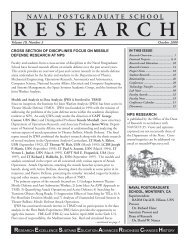Spectral Unmixing Applied to Desert Soils for the - Naval ...
Spectral Unmixing Applied to Desert Soils for the - Naval ...
Spectral Unmixing Applied to Desert Soils for the - Naval ...
You also want an ePaper? Increase the reach of your titles
YUMPU automatically turns print PDFs into web optimized ePapers that Google loves.
Collins et al. (1997) was able <strong>to</strong> successfully use <strong>the</strong> characteristic spectrum of desert<br />
varnish <strong>to</strong> not only detect targets such as military vehicles and fox holes, but tank tracks<br />
on <strong>the</strong> desert varnish itself (Colins et al., 1997). Use of <strong>the</strong> differences in restrahlen<br />
emissivity between <strong>the</strong> desert varnish and o<strong>the</strong>r materials provided a useful visualization<br />
of vehicle traffic and target location (Figure 6) (Collins et al., 1997).<br />
Figure 6. The above image from Collins et al. (1997) shows <strong>the</strong> results of using<br />
principal component analysis achieved using LWIR hyperspectral SEBASS<br />
data <strong>for</strong> <strong>the</strong>ir target detection and terrain classification study.<br />
Hyperspectral imagery have also proved useful <strong>for</strong> several environmental<br />
applications. One in particular that applies <strong>to</strong> this research is <strong>the</strong> use of hyperspectral<br />
data <strong>to</strong> identify plant stress during a study conducted in 2004 (Smith et al., 2004).<br />
Observed spectral changes consisted of decreased reflectance in plants that were<br />
undergoing stress in <strong>the</strong> near infrared range between 0.72 and 0.73 µm (720 and 730 nm)<br />
(Smith et al., 2004). Characteristic changes in reflectance related <strong>to</strong> stress can be seen in<br />
13
















